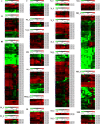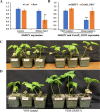Genome-wide identification and characterization of LRR-RLKs reveal functional conservation of the SIF subfamily in cotton (Gossypium hirsutum)
- PMID: 30189845
- PMCID: PMC6128003
- DOI: 10.1186/s12870-018-1395-1
Genome-wide identification and characterization of LRR-RLKs reveal functional conservation of the SIF subfamily in cotton (Gossypium hirsutum)
Abstract
Background: As one of the largest subfamilies of the receptor-like protein kinases (RLKs) in plants, Leucine Rich Repeats-RLKs (LRR-RLKs) are involved in many critical biological processes including growth, development and stress responses in addition to various physiological roles. Arabidopsis contains 234 LRR-RLKs, and four members of Stress Induced Factor (SIF) subfamily (AtSIF1-AtSIF4) which are involved in abiotic and biotic stress responses. Herein, we aimed at identification and functional characterization of SIF subfamily in cultivated tetraploid cotton Gossypium hirsutum.
Results: Genome-wide analysis of cotton LRR-RLK gene family identified 543 members and phylogenetic analysis led to the identification of 6 cotton LRR-RLKs with high homology to Arabidopsis SIFs. Of the six SIF homologs, GhSIF1 is highly conserved exhibiting 46-47% of homology with AtSIF subfamily in amino acid sequence. The GhSIF1 was transiently silenced using Virus-Induced Gene Silencing system specifically targeting the 3' Untranslated Region. The transiently silenced cotton seedlings showed enhanced salt tolerance compared to the control plants. Further, the transiently silenced plants showed better growth, lower electrolyte leakage, and higher chlorophyll and biomass contents.
Conclusions: Overall, 543 LRR-RLK genes were identified using genome-wide analysis in cultivated tetraploid cotton G. hirsutum. The present investigation also demonstrated the conserved salt tolerance function of SIF family member in cotton. The GhSIF1 gene can be knocked out using genome editing technologies to improve salt tolerance in cotton.
Keywords: Genome-wide analysis; Gossypium hirsutum; LRR-RLKs; Salt tolerance.
Conflict of interest statement
Ethics approval and consent to participate
Not applicable.
Consent for publication
Not applicable.
Competing interests
The authors declare that they have no competing interests.
Publisher’s Note
Springer Nature remains neutral with regard to jurisdictional claims in published maps and institutional affiliations.
Figures







Similar articles
-
Genome-wide identification, characterization and expression analysis of populus leucine-rich repeat receptor-like protein kinase genes.BMC Genomics. 2013 May 10;14:318. doi: 10.1186/1471-2164-14-318. BMC Genomics. 2013. PMID: 23663326 Free PMC article.
-
Genome-Wide Analysis of LRR-RLK Gene Family in Four Gossypium Species and Expression Analysis during Cotton Development and Stress Responses.Genes (Basel). 2018 Nov 29;9(12):592. doi: 10.3390/genes9120592. Genes (Basel). 2018. PMID: 30501109 Free PMC article.
-
Genome-wide identification and characterization of SnRK2 gene family in cotton (Gossypium hirsutum L.).BMC Genet. 2017 Jun 12;18(1):54. doi: 10.1186/s12863-017-0517-3. BMC Genet. 2017. PMID: 28606097 Free PMC article.
-
Receptor-like Kinases (LRR-RLKs) in Response of Plants to Biotic and Abiotic Stresses.Plants (Basel). 2022 Oct 10;11(19):2660. doi: 10.3390/plants11192660. Plants (Basel). 2022. PMID: 36235526 Free PMC article. Review.
-
A mini-review on the role of leucine-rich repeat receptor-like kinases (LRR-RLKs) in plant responses to drought stress.Mol Biol Rep. 2025 Jun 5;52(1):554. doi: 10.1007/s11033-025-10621-0. Mol Biol Rep. 2025. PMID: 40471440 Review.
Cited by
-
Salicylic Acid-Induced Expression Profiles of LRR and LRR-RLK Candidate Genes Modulate Mungbean Yellow Mosaic India Virus Resistance in Blackgram and Its Two Wild Non-Progenitors.Plants (Basel). 2024 Dec 23;13(24):3601. doi: 10.3390/plants13243601. Plants (Basel). 2024. PMID: 39771299 Free PMC article.
-
Identification and expression analysis of LRR-RLK genes reveal their roles in plant development and stress responses in Kiwifruit (Actinidia chinensis).Sci Rep. 2025 Jul 20;15(1):26346. doi: 10.1038/s41598-025-12363-2. Sci Rep. 2025. PMID: 40685442 Free PMC article.
-
Physiological responses and small RNAs changes in maize under nitrogen deficiency and resupply.Genes Genomics. 2019 Oct;41(10):1183-1194. doi: 10.1007/s13258-019-00848-0. Epub 2019 Jul 16. Genes Genomics. 2019. PMID: 31313105
-
Resistance Gene Analogs in the Brassicaceae: Identification, Characterization, Distribution, and Evolution.Plant Physiol. 2020 Oct;184(2):909-922. doi: 10.1104/pp.20.00835. Epub 2020 Aug 12. Plant Physiol. 2020. PMID: 32796089 Free PMC article.
-
Weighted Gene Co-Expression Network Analysis Reveals Hub Genes Contributing to Fuzz Development in Gossypium arboreum.Genes (Basel). 2021 May 17;12(5):753. doi: 10.3390/genes12050753. Genes (Basel). 2021. PMID: 34067654 Free PMC article.
References
MeSH terms
Substances
Grants and funding
LinkOut - more resources
Full Text Sources
Other Literature Sources
Research Materials

